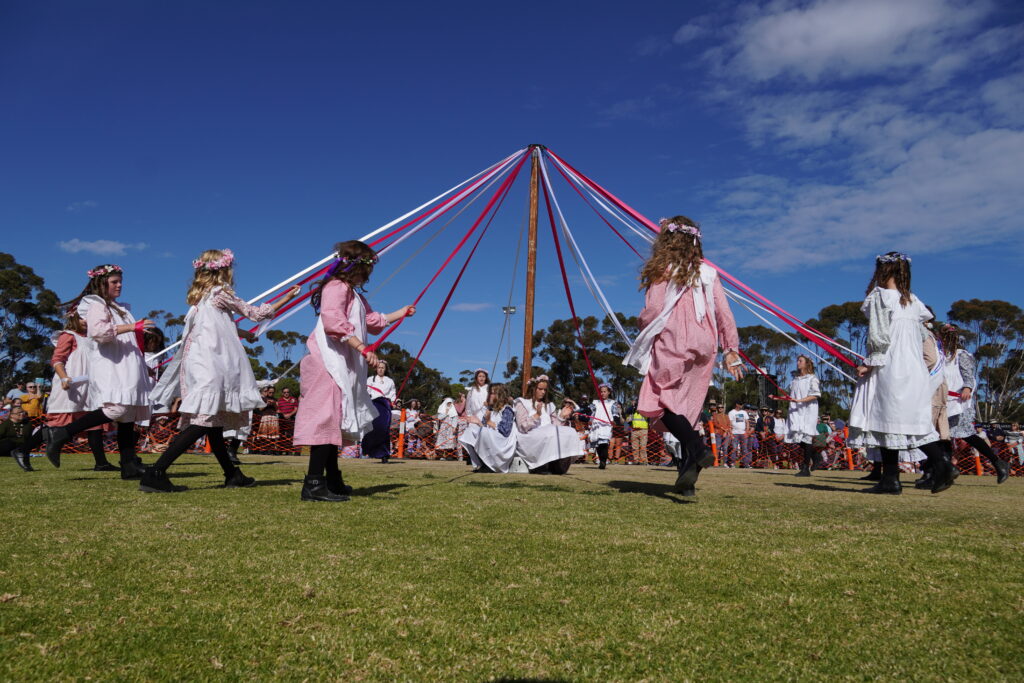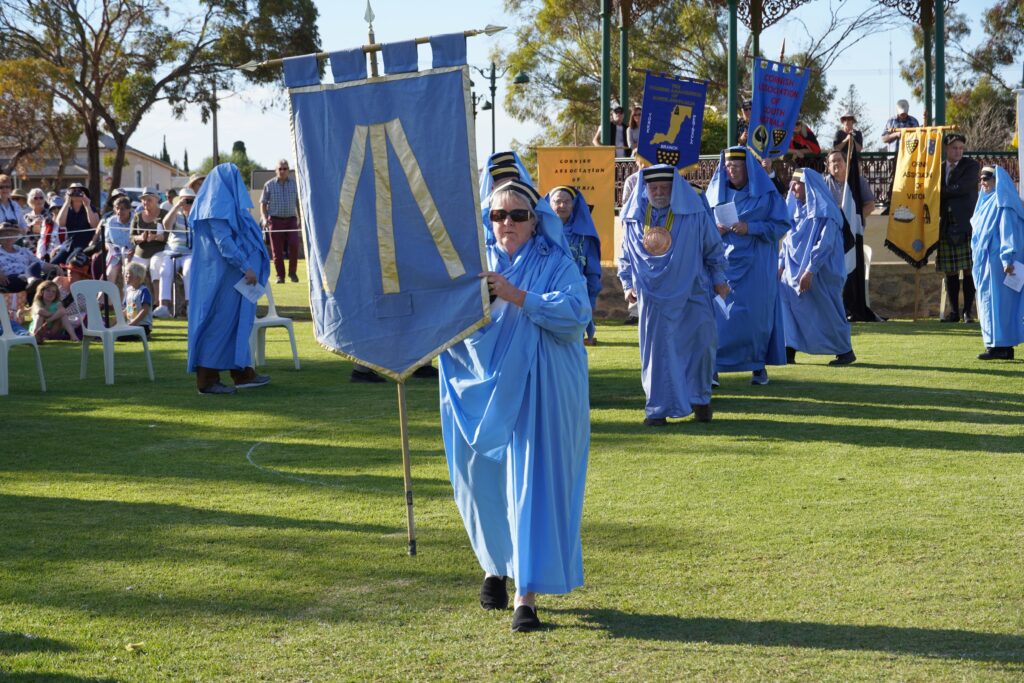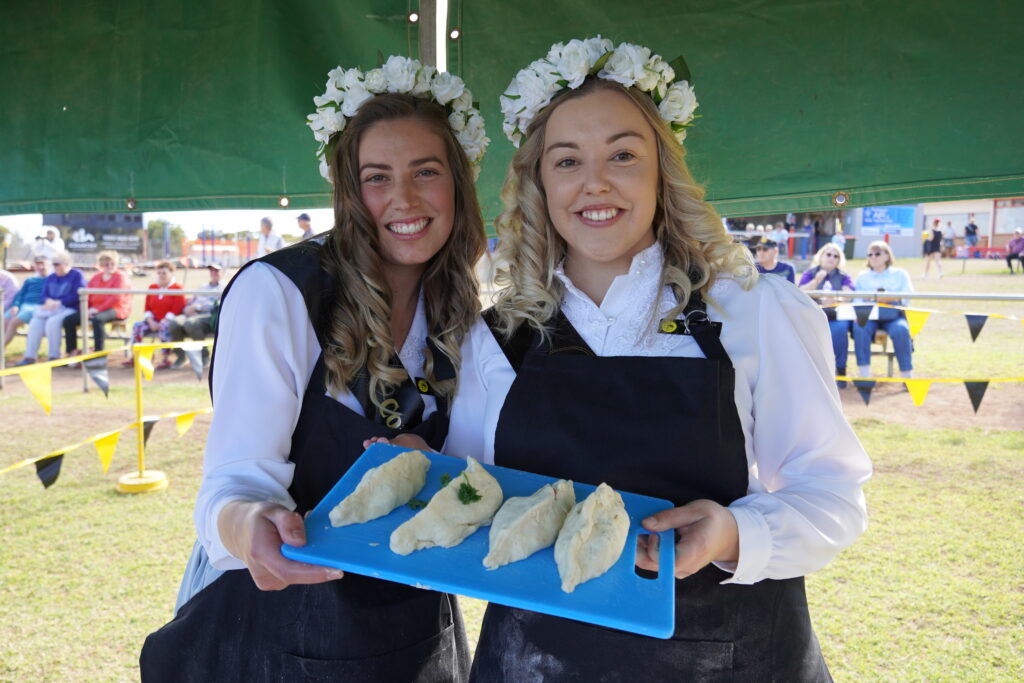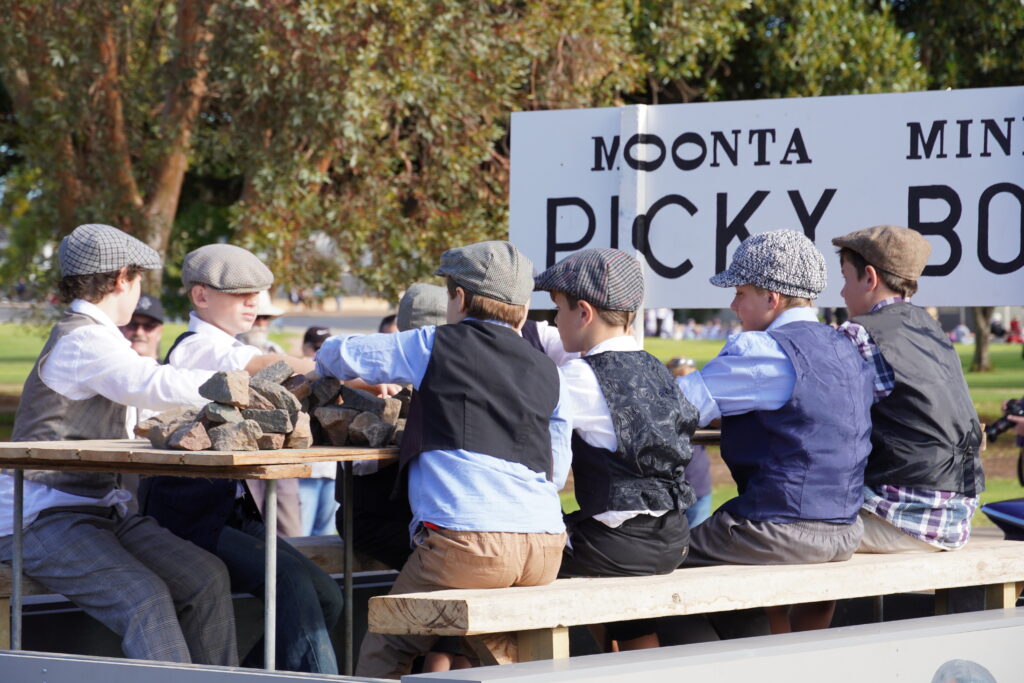KERNEWEK LOWENDER ON AUSTRALIA’S COPPER COAST IS THE BIGGEST CORNISH FESTIVAL IN THE WORLD OUTSIDE OF THE DUCHY. WE SPEAK TO EVENT PRESIDENT LYNN SPURLING ALL ABOUT THIS AWESOME FEST IN MID-MAY…
*This interview was conducted prior to Kernewek Lowender 2023. But it is a good read if you are planning to go to Kernewek Lowender 2025 and any other Kernewek Lowenders in Australia, for that matter…
Kernewek Lowender. Billed as the ‘biggest Cornish festival in the world’ outside of Cornwall itself, this massive event on the Copper Coast of Australia is a major deal. And it was even bigger in May 2023 as its 50th anniversary was celebrated in fine style about as far away from Cornwall as is physically possible.
So what is Kernewek Lowender? Well, we at Proper Cornwall have got a story all about it: here. But, in short, it takes place every two years in the beautiful Copper Coast region in South Australia near Adelaide, primarily in the three towns of Kadina, Wallaroo and Moonta, which are all known for their large Cornish ethnicity which can be traced back to the days of heavy copper mining in the area, when the Cornish experts moved over to teach the locals a thing or 100 in the 1800s.
Tens of thousands of people attend this festival that lasts a week and celebrates all things Cornish, from the maypole dancing to locally created pasties. But why is this event such an important part of the culture in the Copper Coast? Why is it still so, well, Cornish? We sit down with the festival committee’s president, Lynn Spurling, (prior to Kernewek Lowender 2023) to find out…
 Girls dance around a maypole at Kernewek Lowender
Girls dance around a maypole at Kernewek Lowender
Proper Cornwall: Hi Lynn! So before we begin, we’d like to ask if you’re Cornish by heritage…
Lynn Spurling: I do have great-grandparents in a Cornish cemetery so I think this makes me a true Cornish descendant!
PC: Great! We only ask because you, your committee, this event and the whole Copper Coast region of Australia seems to be as passionate about Cornwall as we are over here in our little corner of Europe! For the uninitiated, why is it so, well, Cornish over there in your region?
LS: We have a very strong history and heritage over here that originated from the Cornish settlers who moved across the world in the 19th century for an opportunity to make a new life for themselves. The middle of the 1800s were not so fabulous in Cornwall with a lot of poverty and a lot of lost opportunities and unemployment for them.
PC: So many Cornish people sailed from Europe to Australia to make a new life for themselves?
LS: I am still to this day in awe of their bravery and fortitude to actually get on a ship knowing that they would never return to their homeland again. But for us [in Australia] it was fortuitous because they brought with them all of their wonderful mining history, ability and talent for that particular industry that was so innovative. They crossed the world because we had a huge amount of copper to mine here. And that’s just what they did.
PC: So, like tin is to Cornwall, copper was at the heart of the local community’s success in your region of Australia?
LS: Absolutely. Copper was originally found in a wombat burrow by a shepherd and there’s this great story of some locals trying to get their hands on the lease to the land around that burrow. Mining was obviously hugely competitive and those locals took a big ride to Adelaide to try to get that property deed so they had the rights to the land they wanted to mine. That was 1856. And they were successful.
PC: But they needed mining experts to get the copper out of the ground, right?
LS: Yes. So the families came over from Cornwall. They were the ones who went underground and did the mining. They went through very difficult times from the start, though, because Australia doesn’t have a lot of water. In our area there’s specifically no rivers, no creeks and no streams so they were relying on rainfall and any other sources of water they could get their hands on, so there were some really, really hard times for them. There were a lot of infant deaths due to disease and poor living conditions.
PC: Sounds awful. We couldn’t imagine what that would be like today.
LS: Absolutely. Incidentally, the original mines were the Moonta Mines and the Wallaroo Mines, which is located in Kadina. This confuses everybody. To this day, Moonta is better known as Australia’s Little Cornwall because they’ve managed to preserve much more of the infrastructure down there to keep that historical feel. Our main port is at Wallaroo, so the three towns are within 15 minutes of each other, making up the copper triangle.
 All sorts of historical groups take part in the festival
All sorts of historical groups take part in the festival
PC: So this all happened in the mid-1800s. What happened next?
LS: Well, then the Welsh mining families followed. Those miners are predominantly the ones who smelted the copper and they were the custodians of the port, so they did a lot of the port and seafaring side of things. But, for Kernewek Lowender, we focus on our Cornish heritage. We can actually tell where the Cornish families lived back then by looking at the infrastructure they built. For instance, their chimneys are round because the Cornish say that no devils can hide in the corners whereas the Welsh built square chimneys. We actually have a square chimney in Wallaroo but the rest are round due to the amount of Cornish people who settled here.
PC: So mining was the main industry in the region at that time?
LS: Mining was really prevalent up until the early 1900s. It was paramount when it came to the local economy. A lot of the infrastructure of Adelaide is attributed to the copper mining heritage. Education was also a huge thing and so even the ‘picky boys’, who literally picked through the ore when it was brought to the surface and organised it into high or low grade, had to work their day at work and then go to classes after work. If they didn’t study, they didn’t get paid. Church was also a really huge thing. If you didn’t go to church then you probably didn’t get all of your pay that week.
PC: Family must have been really important, then?
LS: Yes. And it’s that sense of family, as well as Cornish culture as a whole and the wonderful heritage we have here that this festival celebrates. These people crossed the world, made a new life for themselves and eventually accounted for the overall success of South Australia as a state.
PC: So how did the festival come about?
LS: In 1973, a small group of local people saw the relevance of trying to start a festival to acknowledge the importance of our history and Cornish heritage. It was originally timed to be on May Day as it’s a Cornish celebration but also because it’s a shoulder season for us in terms of tourism. Our summer season is October through to April. Pre-COVID, we had about 40,000 people coming to the festival every two years, which is now a week-long event. We only had about 20,000 people coming to it in 2021 due to COVID and travel restrictions, so we are aspiring to get those numbers up to around 40,000 again in 2023.
PC: Can visitors take a look in those old Cornish mines today?
LS: Sadly, the mines closed in the early 1920s. They went bankrupt so that’s why we don’t have a lot of the old infrastructure still in existence. A lot of stuff became scrap metal as they tried to get back as much money as they could to try to recoup the bankruptcy. So, for us, it’s the cultural history that’s important, much more than bricks and mortar. For us, it’s a way to celebrate anything Cornish, from the pasties, the food and the Swanky Ale through to the maypoles, the furry dancing and the church services that acknowledge our ancestors.
PC: Why is it not an annual event?
LS: It’s always been every two years because it’s such a huge festival. This year happens to be our 50th year as we started in 1973 so we are very excited about it. We are Australians out of Cornwall. We celebrate every part of the lifestyle that we have known from those Cornish settlers. There’s a lot of Cousin Jack and Jenny going on. The bloodline comes from Cornwall.
 Pretty and tasty! Notice how these pasties are crimped at the top, though!
Pretty and tasty! Notice how these pasties are crimped at the top, though!
PC: It’s been said that it’s the biggest Cornish festival outside of Cornwall…
LS: It’s hard to tell because there are other festivals that have popped up and I’m probably only aware of those in Australia. We do have very strong Cornish associations in the different states but ours is definitely the largest festival celebrating the Cornish heritage that I know of in Australia. There are a few festivals that celebrate Celtic heritage and not just Cornish, so to solely focus on Cornish heritage, I would say we are the biggest outside of Cornwall which is quite amazing really. But there was such a large population that came here.
PC: So what are we expecting at this year’s festival?
LS: This is special because we are celebrating 50 years. We started with the schoolchildren’s part in the festival in February. We have staff and teachers and students who have taken part in the festival before so there is a bit of continuity. We try to make sure that different children do get the opportunity every two years because we know that our future is in our youth so if we don’t involve them, it won’t follow on for future generations. We want them all to have that opportunity to participate, dress up and understand the value of our heritage.
PC: And other events this year?
LS: Bands, music, maypole dancing, furry dancing and so, so much more. We are re-initiating a lot of the old-fashioned games for the 2023 festival. There will be wheelbarrow, egg-and-spoon, three-legged and sack races. All the favourite races they would have done in that time. We are also introducing an encore event with Celtic music, food and beverages after the festival. There is also community singing and church services. The best way to find out is to look at the events page on our website at kernewek.org/events.
PC: Any pasties being cooked up for the occasion?
LS: Of course! But, for us, we crimp our pasties on the top. The miners would have held the pasty at the top. If you hold the side crimp and try to eat a pasty then it will fall apart. The traditional pasty was seasonal. What was in their gardens or possum or wombat or whatever and, of course, we have the traditional oggy, with sweet and savoury in the pasty. There is no prescribed true ingredient for a pasty, I believe.
PC: Hmmm, some would argue in Cornwall… in fact, what would you say to a Cornish person who may be thinking about jetting over to Australia for the fest?
LS: I’d say they would be warmly welcomed. This is an opportunity for them to experience how important the Cornish lifestyle and heritage has become across the world. You will see a dramatically different environment and landscape to Cornwall but you will also experience that feeling of community and culture that is Cornishness, with an Aussie flair! It’s just unique and special here, so get on a plane and come and experience it!
 The ‘picky boys’ are always at Kernewek Lowender!
The ‘picky boys’ are always at Kernewek Lowender!
PC: Perfect. Anything else going on around festival time in May?
LS: Yes. We are reprinting an original Cornish recipe book for the 50th festival. We would love people in Cornwall to share their recipes with us on Facebook! And we will also be having a display of the past 50 years and we will honour all of the presidents, may queens and life members from all of the festivals, so as part of that display it would be lovely to have some stuff that has been contributed from Cornwall so we can share that with everyone at the event. That would be really special.
PC: What sums up Cornwall and the Cornish spirit for you?
LS: I haven’t been to Cornwall. But I do know that we inherited a lifestyle and values that have made us a unique place in the world. In terms of spirit, I am constantly amazed by the bravery of those Cornish miners who came to the area and then had the foresight to say ‘well, I don’t think there’s going to be a long-term future in mining…’ and so they went out and started farming. They went on to the land, cleared it by hand and used that ingenuity that came from their mining heritage by pioneering aquaculture (farming in water) techniques.
PC: Absolutely. We’re a resourceful bunch in Cornwall…
LS: My great-great grandfather was a Cornish Thomas. He was Cornish built. I am passionate about the area. I’m a librarian. My first festival experience was 1987 and I was crowned may queen at that 1987 festival. I also taught the furry dance and maypole dancing and helped to build the maypole. I also have a great story connected to the festival: I was once single, 21 years old and needed a date to the may queen ball. My husband was my blind date. If it wasn’t for the festival, we may have never met. Since then, we have raised two children who have been involved in the festival too because their mother has forced them to be. My grandchildren also get dressed up for it as well. In 2015, I took on the reins. Since then, we have turned around any financial issues and we know it is sustainable now for the future.
PC: So Kernewek Lowender’s phenomenal success is all down to you?
LS: I’m just the captain steering the ship. It’s really the community that’s behind the festival. Keeping them involved and energised is the important part. We rely not just on our volunteer community but on a lot of our sporting groups, community groups, clubs and individuals to give their time. That’s why being financially sustainable is great because they are then a task force for us and that brings in income for them. It’s also for the economic benefit of the whole area because if we have got people coming and staying and spending their money and buying petrol and food, then it’s just a great value to our whole community. So onwards and upwards for our festival. Here’s to the next 50 years!
Interview by Matt Fleming